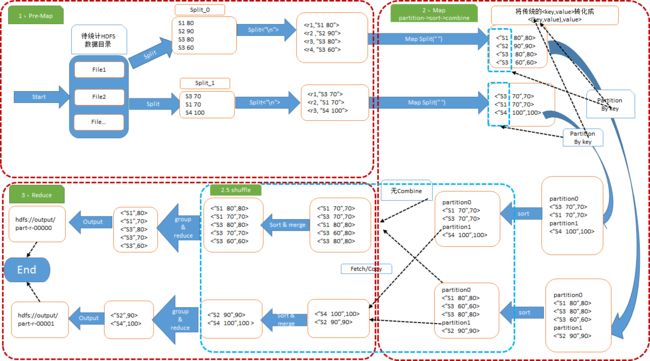java版二次排序的流程
基本的二次排序,以按照两个字段排序为例。先按第一字段升序,再按第二字段降序。二次排序的核心是把原来的key--value对组合成key,称为newkey,value还是value。与原来的wordcount相比,多了一个“分组”步骤,就是把newkey中的第一个字段相同的数据放到一起,再按第二个字段排序。
如图,pre-map阶段,namenode切分文件后,再把文件内容按行(\n)分割,距行首的偏移量作为key值,这一行的内容作为value。这样形成初始的key-value对。
map过程:进入map方法的数据是文件的一行行内容,通过我们自己编程,按照空格切分,然后把前两个字段置为newkey,第二个字段置为value,之后,进行分区过程,按照newkey中的key进行分区,分区依据是key.hashcode%reducenum,得到相同结果的分配到同一个分区,然后分区内进行按照newkey第一字段排序(sort)。
reduce过程:数据被fetch到reduce中,同一个分区号的数据被放到一起,同时进行排序(sort)和聚合(merge),此时的排序是按照第二字段排序的,排序之后,进行分组过程,newkey中key相同的被分配到同一组。我们自己编写reduce方法时,把newkey中的第一字段提取出来作为key,value不变,这样就而完成了二次排序。
代码实现:
import java.io.DataInput;
import java.io.DataOutput;
import java.io.IOException;
import org.apache.hadoop.conf.Configuration;
import org.apache.hadoop.fs.Path;
import org.apache.hadoop.io.IntWritable;
import org.apache.hadoop.io.Text;
import org.apache.hadoop.io.WritableComparable;
import org.apache.hadoop.io.WritableComparator;
import org.apache.hadoop.mapreduce.Job;
import org.apache.hadoop.mapreduce.Mapper;
import org.apache.hadoop.mapreduce.Partitioner;
import org.apache.hadoop.mapreduce.Reducer;
import org.apache.hadoop.mapreduce.lib.input.FileInputFormat;
import org.apache.hadoop.mapreduce.lib.output.FileOutputFormat;
import org.apache.hadoop.util.GenericOptionsParser;
// 启动mr的driver类
public class SecondSortV3 {
/**
* 自定义的newKey
*/
public static class KeyPairWritable implements
WritableComparable {
// 组合key,key1是分区key,key2是二次排序key
private String key1;
private int key2;
public KeyPairWritable() {
}
public KeyPairWritable(String key1, int key2) {
this.set(key1, key2);
}
// 一次性将两个key设置成完
public void set(String key1, int key2) {
this.key1 = key1;
this.key2 = key2;
}
// 当map端写出的时候的序列化方法,即map如何将对象写出去,保证与读取的顺序一致
@Override
public void write(DataOutput arg0) throws IOException {
arg0.writeUTF(key1);
arg0.writeInt(key2);
}
// 在reducer读取数据时候的反序列化方法,即reduce如何将对象读取出来,保证与写入的顺序一致
@Override
public void readFields(DataInput arg0) throws IOException {
this.key1 = arg0.readUTF();
this.key2 = arg0.readInt();
}
// 自定义比较器方法,先比较key1,确定分区号。在分区号相同的情况下,去比较key2
// 就不需要单独写一个Comparator了
public int compareTo(KeyPairWritable o) {
int compare = this.key1.compareTo(o.key1);
if (compare != 0) {
return compare;
} else {
// 降序排列,故将o放到前边即可
return Integer.valueOf(o.key2).compareTo(
Integer.valueOf(this.getkey2()));
}
}
public int getkey2() {
return key2;
}
public void setkey2(int key2) {
this.key2 = key2;
}
public String getkey1() {
return key1;
}
public void setkey1(String key1) {
this.key1 = key1;
}
}
// map类,实现map函数
public static class LineProcessMapper extends
Mapper {
// 暂存每个传过来的词的值,省掉重复申请空间
private KeyPairWritable outputKey = new KeyPairWritable();
private IntWritable outputValue = new IntWritable();
// 核心map方法的具体实现,逐个对去处理
public void map(Object key, Text value, Context context)
throws IOException, InterruptedException {
// 通过context对象,将map的输出逐个输出
String tempLine = value.toString();
if (tempLine != null && tempLine.trim().length() > 0) {
String[] columnArray = tempLine.split("\\s");
outputKey.set(columnArray[0], Integer.parseInt(columnArray[1]));
outputValue.set(Integer.parseInt(columnArray[1]));
context.write(outputKey, outputValue);
}
}
}
/**
* 自定义分区类,包证同key的记录,如S1,S2等,能映射到相同的reduce端去处理
*/
public static class SecondPartitioner extends
Partitioner {
// 采集默认的HashPartiton实现即可
@Override
public int getPartition(KeyPairWritable key, IntWritable value,
int numPartitions) {
/*
* 默认的实现 (key.hashCode() & Integer.MAX_VALUE) % numPartitions
* 让key中first字段作为分区依据
*/
return (key.getkey1().hashCode() & Integer.MAX_VALUE)
% numPartitions;
}
}
/**
* 在shuffle阶段的sort全局排序完成后,如何对数据记录进行分组
*/
public static class SecondSortGroupComparator extends WritableComparator {
// 对象KeyPairWritable.class注册,让比较器知道该对象并能够初始化
protected SecondSortGroupComparator() {
super(KeyPairWritable.class, true);
}
@Override
public int compare(WritableComparable first, WritableComparable second) {
if (first == null || second == null) {
return 0;
}
KeyPairWritable newKey1 = (KeyPairWritable) first;
KeyPairWritable newKey2 = (KeyPairWritable) second;
// 自定义按原始数据中第一个key分组
return newKey1.getkey1().compareTo(newKey2.getkey1());
}
}
// reduce类,实现reduce函数
public static class SortReducer extends
Reducer {
private Text outputKey = new Text();
// 核心reduce方法的具体实现,逐个去处理
public void reduce(KeyPairWritable keyPair,
Iterable values, Context context)
throws IOException, InterruptedException {
// 进来时已经排序完成
outputKey.set(keyPair.getkey1());
for (IntWritable val : values) {
context.write(outputKey, val);
}
}
}
// 启动mr的driver方法
public static void main(String[] args) throws Exception {
// 得到集群配置参数
Configuration conf = new Configuration();
// 参数解析器
GenericOptionsParser optionParser = new GenericOptionsParser(conf, args);
String[] remainingArgs = optionParser.getRemainingArgs();
if ((remainingArgs.length != 2)) {
System.err
.println("Usage: yarn jar jar_path main_class_path -D参数列表 ");
System.exit(2);
}
// 设置到本次的job实例中
Job job = Job.getInstance(conf, "Mrs_WuHo_O");
// 指定本次执行的主类是WordCount
job.setJarByClass(SecondSortV3.class);
// 指定map类
job.setMapperClass(LineProcessMapper.class);
// 指定partition类
job.setPartitionerClass(SecondPartitioner.class);
job.setGroupingComparatorClass(SecondSortGroupComparator.class);
// 指定reducer类
job.setReducerClass(SortReducer.class);
// 指定job输出的key和value的类型,如果map和reduce输出类型不完全相同,需要重新设置map的output的key和value的class类型
job.setMapOutputKeyClass(KeyPairWritable.class);
job.setMapOutputValueClass(IntWritable.class);
job.setOutputKeyClass(Text.class);
job.setOutputValueClass(IntWritable.class);
// 指定输入数据的路径
FileInputFormat.addInputPath(job, new Path(remainingArgs[0]));
// 指定输出路径,并要求该输出路径一定是不存在的
FileOutputFormat.setOutputPath(job, new Path(remainingArgs[1]));
// 指定job执行模式,等待任务执行完成后,提交任务的客户端才会退出!
System.exit(job.waitForCompletion(true) ? 0 : 1);
}
} 编写完毕,打好jar包,提交到hdfs集群上,然后执行,执行的时候要用到系统参数
yarn jar TlHadoopCore-jar-with-dependencies.jar \
com.Mrs_WuHo_O.examples.secondsort.SecondSortV3 \
-Dmapred.output.compress=true \
-Dmapred.output.compression.codec=org.apache.hadoop.io.compress.GzipCodec \
-Dmapred.reduce.tasks=1 \
/tmp/Mrs_WuHo_O/input_secondsort /tmp/tianliangedu/output55